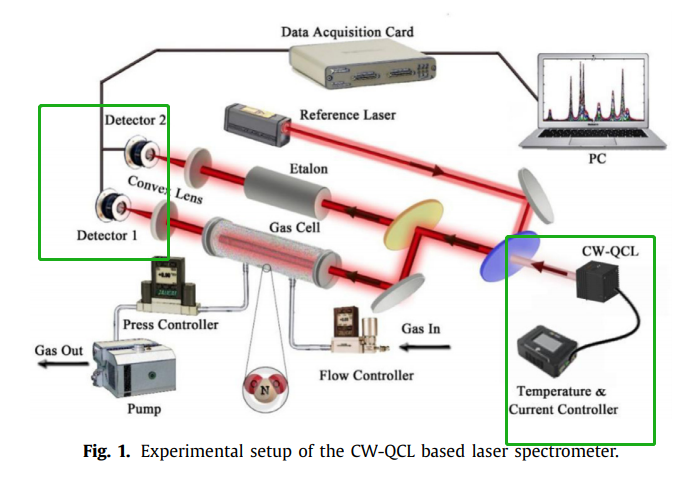Anhui University used QCL to achieve precise NO2 measurement
Abstract
Prof. Sheng Zhou from Anhui University published a paper called "Measurement of Line Intensities of NO2 Near 6.2μm by Quantum Cascade Laser Spectrometer" in the Journal of Quantitative Spectroscopy & Radiative Transfer. HealthyPhoton participated in the experiment and provided the quantum cascade laser (QCL) and drive control products for the experiment.

Figure 1. Screenshot of the first page of the paper
Application
Nitrogen dioxide (NO2) is a common pollutant that mainly comes from fossil-burning fuels, lightning, and microbial life activity in the soil. NO2 can cause photochemical smog, which leads to an increase in rain acidity. Exposure to high concentrations of NO2 continuously may cause a variety of short - and long-term adverse effects on the respiratory system of humans and animals. Therefore, the development of a cost-effective, stable, and sensitive system for NO2 monitoring is extremely important.
Chemiluminescence and wet chemical analysis are the most common detection methods o for NO2 detection. However, these methods have a slow response time and are unable to accurately distinguish NO and NO2, thus their applications are very limited. The optical method based on absorption spectrum provides a powerful analytical method for trace gas analysis which ensures extremely high sensitivity, high selectivity, and rapid response.
NO2 has a distinct absorption spectrum in both UV-Vis and IR regions. It is more suitable for the detection of NO2 using the IR band since its vibrational rotation spectrum in the IR band is simple and has no overlap with other molecules. Due to the fundamental frequency absorption of most atmospheric molecules is located in the mid-IR band, the laser absorption spectroscopy based on the mid-IR band is an ideal choice for analyzing trace gases. Commercial continuous wave(CW) QCLs have been widely used in the quantitative spectral analysis of NO2. These lasers have the advantages of high output power, room temperature (RT) operation, extremely narrow line-widths, and wide spectrum tun-ability.

Figure 2. Experimental setup based on CW-QCL laser spectrometer:
HealthyPhoton’s products are highlighted in the green boxes

Figure 3. HealthyPhoton’s product applied to this project
The research group from Anhui university set up the experiment based on a CW- QCL device. With customized laser collimation and heat dissipation encapsulation provided by HealthyPhoton, m11the laser beam went through only a few optical devices, which reduced i the power loss and interferences tremendously. The intensity of several absorption lines of NO2 molecules between 1629 cm-1 and 1632 cm-1 (v3 band) were studied in detail. The results were consistent with the NO2 spectral intensity % in the HITRAN database, which offers a great value to improve the NO2 spectral database.
Related Products
1. QC750-Touch™ Quantum Cascade Laser Driver
- All-in-one module includes both current driver and temperature controller
- Linear output to TEC greatly extends the Peltier device lifetime
- Output protection mechanisms ensure the safety of QCL chip: adjustable current clamp, output ramp start, over-voltage and under-voltage protection, over temperature protection and short-circuit output protection
- Touchscreen UI is convenient for user operation and status monitoring
- It is easy to set up and fully compatible with HealthyPhoton’s QCL emitter module (HPQCL-Q)
- Compact package specially designed for Quantum Cascade Lasers
- Output beam collimated and extremely low optical interference fringes
- Integrated semiconductor TEC temperature control and low-noise air fan with 20W heat dissipation capability, ensuring constant chip temperature
- Output optical power can reach up to 100 mW
- Compatible with QC750-TouchTM QCL driver
- Cables and connectors included
3. HPPD-M-B™ Amplified MCT Photodetector
HealthyPhoton's TEC cooled MCT Amplified Photodetector is a highly sensitive photovoltaic HgCdTe (mercury cadmium telluride. MCT) detector for sensitive detection of photons in the mid-IR spectral range from 2 to 12 µm.
- Sensitive to mid-IR light from 2 ~ 12 µm
- Signal bandwidth: DC/AC ~ 20 MHz
- TEC to hold the temperature at ~190K that greatly reduces thermal noise
- Low-noise, wide-bandwidth pre-amplifier to convert photocurrent into a voltage signal
- Cost-effective
Reference
Cost-Sheng Zhou et al. “Measurement of Line Intensities of NO2 Near 6.2μm by Quantum Cascade Laser Spectrometer” Journal of Quantitative Spectroscopy and Radiative Transfer, vol. 250, July 2020. Tel:+86-400 961 6990 Email:info@healthyphoton.com
Add:Room 305, Building 1, Zhongchuang Science Park, Jinyuan Road, Panhuo Street, Yinzhou District, Ningbo City,China
Tel:+86-400 961 6990 Email:info@healthyphoton.com
Add:Room 305, Building 1, Zhongchuang Science Park, Jinyuan Road, Panhuo Street, Yinzhou District, Ningbo City,China


